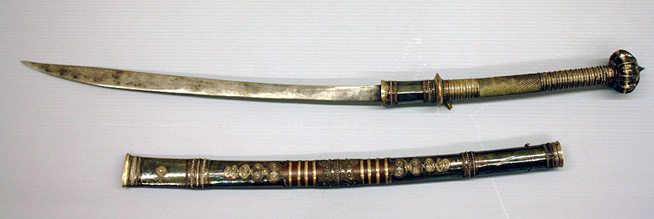Weapon Wednesday: The Burmese Dha

Across South East and South Asia the traditional weapons often bear close affinities to the tools of the region. An example of this is the dha, the single edged sword most typically associated with Burma (modern Myanmar). These are still used to this day by peoples such as the Shan essentially as a combination of machete and weapon. The term "dha" really means a knife, and the sword is more fully known as a dha iwe. The exact origins of this weapon are hotly debated but certainly have a long history in the region judging by their being depicted in the 12th century AD temple complex at Angkor Wat. Conceivably they had a very long history as a bush knife, but were also useful from horseback as the long handle gave them excellent reach (the Angkor Wat examples are of horsemen). Like all traditions of fighting, Burma has it's own highly developed form of martial art, known as banshay. It is closely related to the martial arts systems of the region, and includes use of the dha. In the banshay tradition, learners would have their swords locked in their scabbards, and with this they would practice. If the sword was needed, the scabbard would have to be broken.
These swords were acquired by Charles Currelly between 1906 and 1927 from W. H. Fenton & Sons of Holywell Street and New Oxford Street, London, who were dealers in antiquities but it seems especially in arms and armour. Fentons also supplied The British Museum; the Royal Armouries Museum, Leeds; the Fitzwilliam Museum, Cambridge; the Pitt-Rivers Museum, Oxford; and the Glasgow Museum and Art Gallery.

This everyday dha would probably be just as happy to be used on shrubbery as much as another swordsman, with rattan-bound grip and scabbard, and original suspenion chord, probably 19th century - 927.59.52.A-B - sword is 76.3 cm long

Probably from Burma, this dha has a carved ivory and silver grip, 18th-19th century - 927.59.49.A-B - sword is 81.7 cm long

Detail of 927.59.49.A-B (photo by Bill Pratt).

Possibly from Kachin, Burma, this dha has a silver covered grip and scabbard, 19th century - 924.55.45.A-B - sword is 95.7 cm long .

Detail of 924.55.45.A-B (photo by Bill Pratt).

Possibly from Thailand or Shan, Burma, with ivory and silver hilt, and silver-covered scabbard, 19th century - 906.11.16.A-B - sword is 76.2 cm long

12th century AD warriors from Angkor Wat with dha-like swords.
